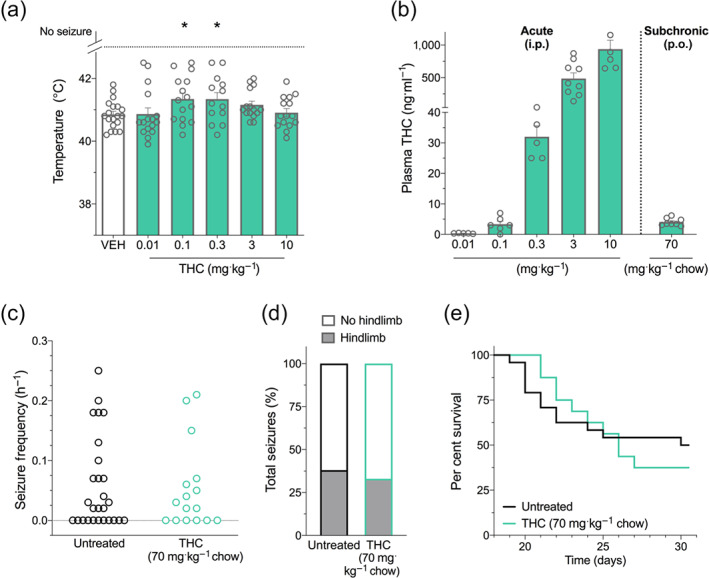FIGURE 2.

Δ9‐THC treatment in Scn1a +/− mice. (a) Threshold temperature of individual mice for generalized tonic–clonic seizure (GTCS) induced by hyperthermia following acute intraperitoneal treatment with vehicle (VEH) or varying doses of THC (green bars). THC (0.1 and 0.3 mg·kg−1) significantly increased the temperature threshold for hyperthermia‐induced seizures. The average temperatures of seizure induction are depicted by the bars, and error bars represent SEM, with n = 13–19 per group (* P < 0.05; log‐rank Mantel–Cox). (b) Plasma concentrations of THC from individual experimental animals. THC plasma concentrations measured following acute intraperitoneal (i.p.) administration of THC in Scn1a +/− mice used in hyperthermia‐induced seizure experiments or following subchronic oral (p.o.) administration of 70 mg THC·kg−1 chow. The average plasma THC concentrations are depicted by the bars, and error bars represent SEM, with n = 5–9 per group. (c) GTCS frequency of individual untreated and THC‐treated mice. Drug treatment administered orally through supplementation in chow was initiated following the induction of a single thermally induced seizure. Unprovoked, spontaneous GTCSs were quantified over a 60 h recording period. THC treatment had no effect on incidence or frequency of seizures, with n = 16–27 per group (Fisher's exact text and one‐way ANOVA followed by Bonferroni's post hoc, respectively). (d) Proportion of spontaneous GTCS with (grey bars) or without (white bars) full tonic hindlimb extension is depicted. Seizure severity was not affected by THC treatment (Fisher's exact test). Total number of spontaneous GTCS was 71 (untreated) and 45 (THC). (e) Survival curves comparing untreated and THC‐treated mice. Treatment began at postnatal day 18 (P18), and survival was monitored until P30. Survival of Scn1a +/− mice was not affected by THC treatment, with n = 16–27 per group (log‐rank Mantel–Cox)
